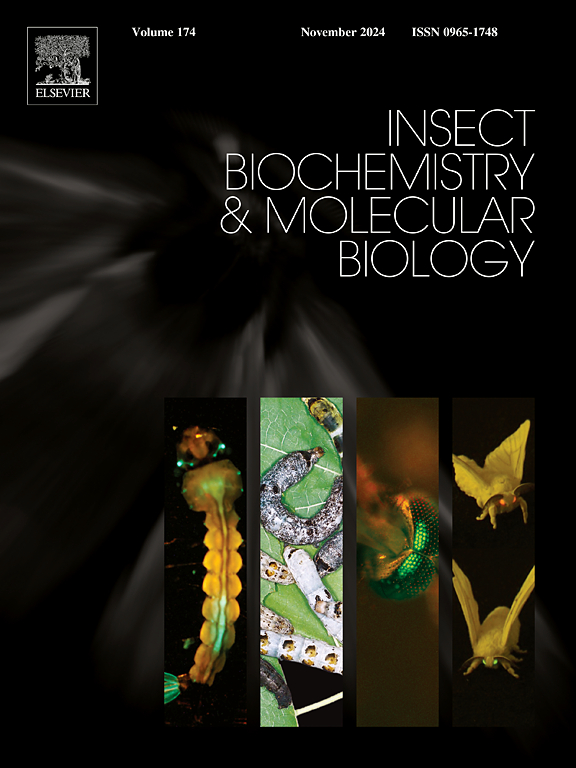注释豌豆蚜(Acyrthosiphon pisum)中的转录因子、染色质相关因子和基础转录机制,并开发 ATFdb 数据库,为转录调控研究提供资源。
IF 3.7
2区 农林科学
Q2 BIOCHEMISTRY & MOLECULAR BIOLOGY
引用次数: 0
摘要
豌豆蚜(Acyrthosiphon pisum)是功能基因组学和比较基因组学中一个新兴的模型系统,部分原因是有了新的基因组学方法,以及社会各界致力于这一重要作物害虫的不同测序和注释工作。豌豆蚜还被用作研究蚜虫奇妙生物特性的模型,如蚜虫广泛的多态性、细菌细胞封闭的营养共生,或蚜虫对韧皮部汁液所代表的高度不平衡饮食的适应性。要深入了解所有这些过程的分子基础,就必须对转录因子(TFs)进行适当的注释,这样才能重建/推断蚜虫的基因调控网络。最新版本的A. pisum基因组组装和注释代表了首个染色体水平的豌豆蚜虫基因组,我们利用该基因组注释了完整的A. pisum TFs,并通过注释编码染色质相关蛋白和基础转录机制蛋白的基因对这一信息进行了补充。这些注释是结合了来自黑腹果蝇模型的信息(我们还提供了一份重新研究过的这些蛋白的清单)和新的预测结果完成的。通过对两个模型系统的比较,我们确定了每个基因组中的主要损失或扩展,同时对 ZNF TFs(某些家族在豌豆蚜中扩展)和 Hox 基因簇(与黑腹果蝇相比,豌豆蚜中的基因位置出现了重组)进行了更深入的分析。所有注释都可以通过蚜虫转录因子数据库(ATFdb)向社区提供,该数据库整合了我们生成的各种注释。ATFdb 是研究蚜虫基因调控的宝贵资源。本文章由计算机程序翻译,如有差异,请以英文原文为准。

Annotation of transcription factors, chromatin-associated factors, and basal transcription machinery in the pea aphid, Acyrthosiphon pisum, and development of the ATFdb database, a resource for studies of transcriptional regulation
The pea aphid, Acyrthosiphon pisum, is an emerging model system in functional and comparative genomics, in part due to the availability of new genomic approaches and the different sequencing and annotation efforts that the community has dedicated to this important crop pest insect. The pea aphid is also used as a model to study fascinating biological traits of aphids, such as their extensive polyphenisms, their bacteriocyte-confined nutritional symbiosis, or their adaptation to the highly unbalanced diet represented by phloem sap. To get insights into the molecular basis of all these processes, it is important to have an appropriate annotation of transcription factors (TFs), which would enable the reconstruction/inference of gene regulatory networks in aphids. Using the latest version of the A. pisum genome assembly and annotation, which represents the first chromosome-level pea aphid genome, we annotated the complete repertoire of A. pisum TFs and complemented this information by annotating genes encoding chromatin-associated and basal transcription machinery proteins. These annotations were done combining information from the model Drosophila melanogaster, for which we also provide a revisited list of these proteins, and de novo prediction. The comparison between the two model systems allowed the identification of major losses or expansions in each genome, while a deeper analysis was made of ZNF TFs (with certain families expanded in the pea aphid), and the Hox gene cluster (showing reorganization in gene position in the pea aphid compared to D. melanogaster). All annotations are available to the community through the Aphid Transcription Factors database (ATFdb), consolidating the various annotations we generated. ATFdb serves as a valuable resource for gene regulation studies in aphids.
求助全文
通过发布文献求助,成功后即可免费获取论文全文。
去求助
来源期刊
CiteScore
7.40
自引率
5.30%
发文量
105
审稿时长
40 days
期刊介绍:
This international journal publishes original contributions and mini-reviews in the fields of insect biochemistry and insect molecular biology. Main areas of interest are neurochemistry, hormone and pheromone biochemistry, enzymes and metabolism, hormone action and gene regulation, gene characterization and structure, pharmacology, immunology and cell and tissue culture. Papers on the biochemistry and molecular biology of other groups of arthropods are published if of general interest to the readership. Technique papers will be considered for publication if they significantly advance the field of insect biochemistry and molecular biology in the opinion of the Editors and Editorial Board.

 求助内容:
求助内容: 应助结果提醒方式:
应助结果提醒方式:


